The 2021 List Establishments (LE) in La Union contains information on about 9,909 establishments operating in the province and employing about 44.04 thousand persons.
Services dominate broad industry groups in terms of number of establishments
By broad industry group, Services (Sectors G to S) recorded the highest number of establishments with 8,263 or 83.39 percent of the total number of establishments in the province in 2021. Industry (Sectors B to F) followed with 1,519 establishments or 15.33 percent share. On the other hand, Agriculture (Sector A) had the least number of establishments with 127 or 1.28 percent share to the total number of establishments (Figure 1).
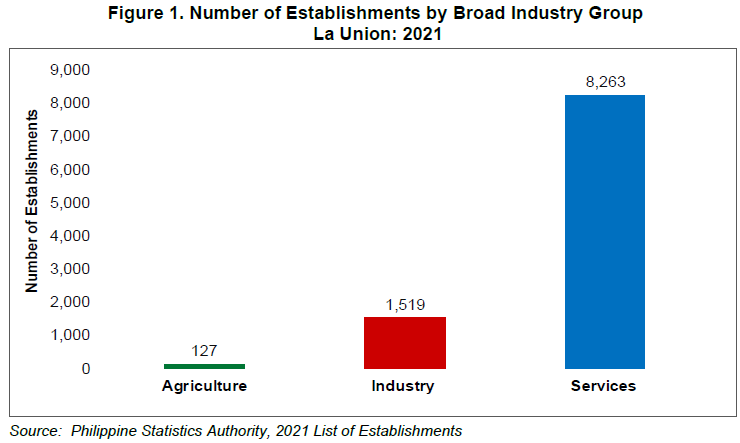
Wholesale and Retail Trade; Repair of Motor Vehicles and Motorcycles had the most number of establishments
Among sectors, Wholesale and Retail Trade; Repair of Motor Vehicles and Motorcycles (G) recorded the highest number of establishments with nearly half (48.32%) of the total establishments in the province or 4,788 establishments. Second in rank was Accommodation and Food Service Activities (I) contributing 14.81 percent to the total or 1,468 establishments. It was followed closely in the third rank by the Manufacturing sector (C) with 14.70 percent share or 1,457 establishments. (Figure 2)

City of San Fernando remains the center of business and industry in La Union
The City of San Fernando continued to be the center of business and industry in La Union with a total of 2,850 establishments or 28.76 percent of the total number of establishments in 2021. It was followed by the municipalities of Bauang, Agoo, Rosario, and Bacnotan with 951 (9.60%), 692 (6.98%), 627 (6.33%), and 615 (6.21%) establishments, respectively. (Figure 3)
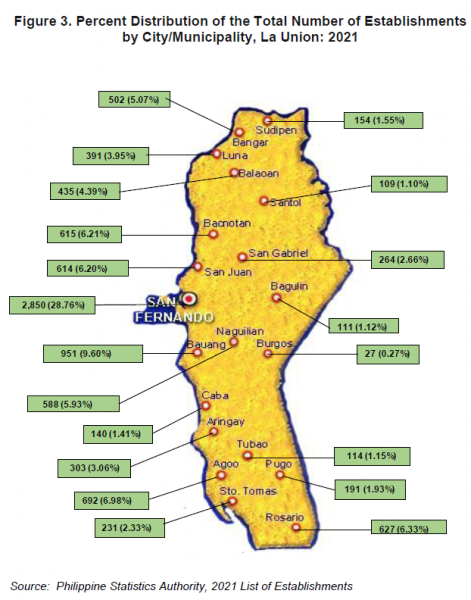
Medium and Large Establishments comprised less than one percent of the total number of establishments
By establishment grouping, Micro establishments (with total employment of 1 to 9) dominated the count of establishments with 9,243 comprising 93.28 percent of the total number of establishments in the province in 2021. Small establishments (with total employment of 10 to 99) ranked second with 633 establishments or 6.39 percent of the total. Meanwhile, the combined number of establishments from Medium establishments (with total employment of 100 to 199) with 21 establishments and Large establishments (with total employment of 200 and over) with 12 establishments accounted to 0.33 percent of the total number of establishments in the province in 2021 (Figure 4).
Majority of the large establishments in the province were engaged in Manufacturing (C); Electricity, Gas, Steam, and Air Conditioning Supply (D); and Education (P) with two establishments each.
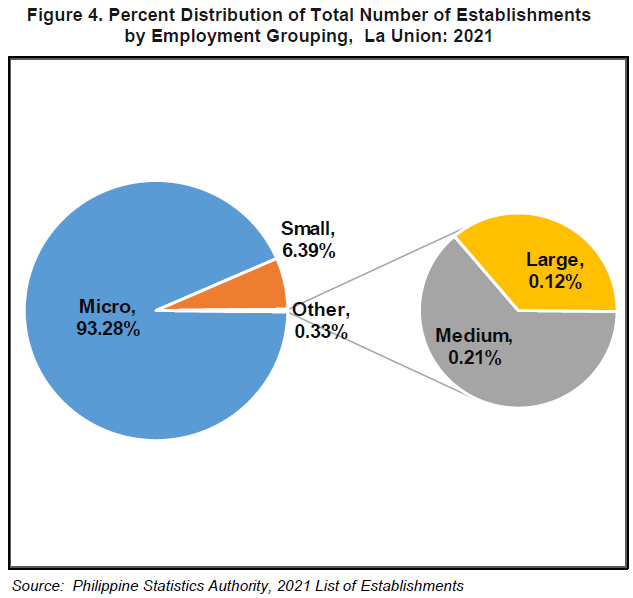
Agriculture had the lowest total employment but highest in terms of average employment per establishment
By broad industry group, Services recorded the highest employment with 35,809 persons which comprised 81.31 percent of the total employment generated by the establishments in the province in 2021. Meanwhile, Industry and Agriculture employed 7,501 persons or 17.03 percent and 731 persons or 1.66 percent of the total employment, respectively (Figure 5).
On the other hand, in terms of average employment, Agriculture had the highest average of six persons per establishment. It was followed by Industry and Services with five and four persons per establishment, respectively.

About two-fifths of the total employment was generated by Wholesale and Retail Trade; Repair of Motor Vehicles and Motorcycles
Among sectors, Wholesale and Retail Trade; Repair of Motor Vehicles and Motorcycles (G) surpassed other sectors with generated employment of 18,027 or 40.93 percent of the total employment in 2021. The Manufacturing (C) ranked second which employed 5,901 persons or 13.40 percent of the total employment while Accommodation and Food Service Activities (I) ranked third with 5,853 persons or 13.29 percent of the total employment in 2021 (Figure 6).
On the other hand, Water Supply, Sewerage, Waste Management, and Remediation Activities (E) contributed the least employment with a total of 65 persons or 0.1 percent share to the total employment in the province.
Moreover, the three sectors with the biggest average employment per establishment were: Electricity, Gas, Steam and Air Conditioning Supply (D) with an average of 63 employees per establishment; Education (P) with an average of 26 employees per establishment and; Mining and Quarrying (B) with an average of 17 employees per establishment.

Explanatory Notes
A. List of Establishments (LE)
The List of Establishments (LE) of the Philippine Statistics Authority (PSA) is a register containing records of establishments operating in the Philippines that are captured through door-to-door canvassing, lists from secondary sources, and information from the submitted survey reports.
The statistical unit in the LE is the establishment. An establishment is defined as an economic unit:
1. under a single ownership or control, i.e., under a single legal entity;
2. engages in one or predominantly one kind of economic activity; and
3. at a single fixed physical location.
The LE is maintained by the PSA primarily to serve as the source of sampling frame for all the establishment-based surveys and censuses conducted by the PSA.
The Updating of the List of Establishments (ULE) is a regular activity undertaken to provide an updated and reliable LE. Generally, the conduct of a nationwide ULE operation is being done during the reference year of the Census of Philippine Business and Industry (CPBI), that is, one year prior to the actual census data collection. On years when nationwide ULE is not conducted, the door-to-door canvassing operations to update the LE is done only on a limited scale, that is, in selected areas (usually in economic growth areas or areas with special concerns), and/or only for certain groups of industries or specific economic units (e.g., Main Offices only). The coverage depends mainly on the availability of resources and the data needs. The regular updating is supplemented by information from available lists from other sources and from establishment's reports to surveys and censuses undertaken by the PSA.
B. Scope and Coverage of the List of Establishments
The LE covers establishments engaged in economic activities under the 18 industry sections as defined in the 2009 Philippine Standard Industrial Classification (PSIC) with the 2019 updates. The table below presents the scope and coverage of the LE.

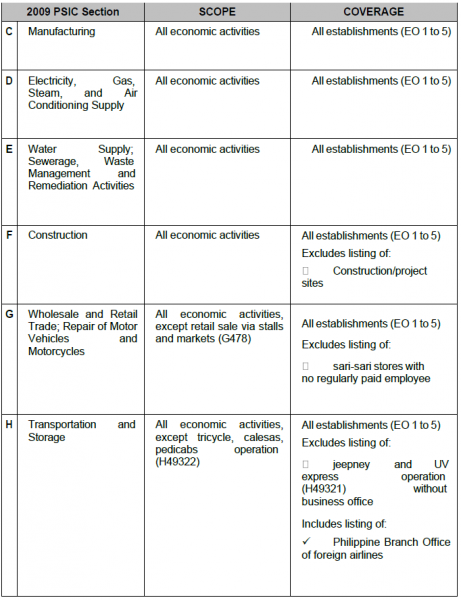
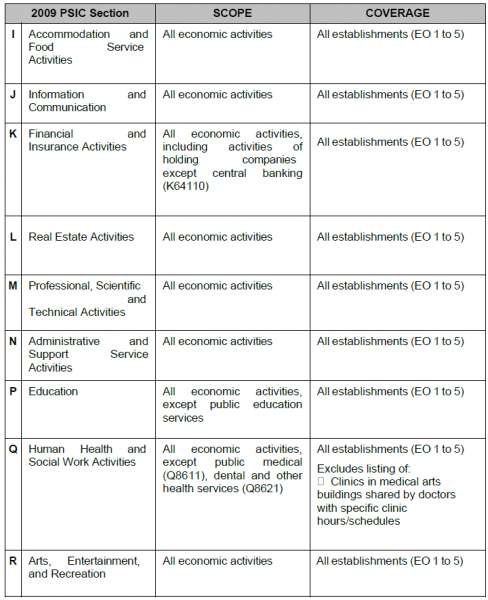

C. Exclusions in the LE
Units not included in the LE are the following:
-
Ambulant peddlers (“maglalako”) and hawkers and movable stall either along a public road or in a marketplace;
-
Open stalls in shopping centers, malls, and markets;
-
Individual professionals and technical workers or craftsmen who do not maintain fixed offices or shops;
-
Construction or project sites;
-
Sari-sari stores with no regularly paid employee;
-
Retail sale via stalls and markets;
-
Jeepney and AUV (“FX”) operation (if without business office);
-
Tricycle, calesas, pedicabs operation;
-
Public education services;
-
Public medical, dental, and other health services;
-
Doctor’s offices or clinics in hospitals;
-
Medical clinics shared by at least two doctors;
-
Central banking (BSP);
-
Government administrative and judicial offices; military and police camps and installations; government offices engaged in construction work;
-
Business associations, employer’s organizations, religious organizations, places of worship, political organizations, and other membership organizations; and
-
Extra-territorial Organization and Bodies (World Health Organization, UNESCO, etc.).
D. Taxonomy of Establishments
Establishments listed in the LE are classified according to the following:
1. Economic Organization (EO) could be:
EO 1 - single establishment (no branch nor main office)
EO 2 - branch (main office is located elsewhere within the country)
EO 3 - establishment and main office (both located in the same address and with branch/es elsewhere)
EO 4 - main office only (office of an establishment/s which controls, supervises, directs other establishment/s)
EO 5 - ancillary unit (an economic unit that operates primarily or exclusively for a related establishment or group of establishments and produces goods or services that support but do not become part of the output of those establishment)
2. Legal Organization (LO) could be:
LO 1 - single proprietorship
LO 2 - partnership
LO 3 - government corporation
LO 4 - stock corporation
LO 5 - non-stock, non-profit corporation
LO 6 - cooperative
LO 7- other (e.g., foundations)
3. Geographic Location is based on the latest Philippine Standard Geographic Classification (PSGC).
4. Industry Classification
In general, the industrial classification of an economic unit is determined by the activity from which it derives its major income or revenue. The industries are coded using the 2009 Philippine Standard Industrial Classification (PSIC) with 2019 updates.
5. Establishment Size is based on Total Employment (TE) as follows:
The TE refers to the total number of persons who work in or for the establishment. This includes paid employees, working owners, unpaid workers, and all employees who work full-time or part-time including seasonal workers. Persons working in the establishment but under a sub-contract agreement or manpower agencies/contractors are excluded.
Size 0 - with TE of 1 to 4
Size 1 - with TE of 5 to 9
Size 2 - with TE of 10 to 19
Size 3 - with TE of 20 to 49
Size 4 - with TE of 50 to 99
Size 5 - with TE of 100 to 199
Size 6 - with TE of 200 to 499
Size 7 - with TE of 500 to 999
Size 8 - with TE of 1000 to 1999
Size 9 - with TE of 2000 and over
6. MSME Classification
For statistical purposes, establishments are grouped according to total employment as follows:
Micro - Establishments with Total Employment of 1 to 9
Small - Establishments with Total Employment of 10 to 99
Medium - Establishments with Total Employment of 100 to 199
Large - Establishments with Total Employment of 200 and Over
E. The Nationwide 2021 Updating of the List of Establishments (ULE)
In response to the demand for an updated information on establishment business units during the period of pandemic, the PSA conducted a nationwide ULE in 2021. The 2021 ULE was a special activity undertaken to collect information on the status and characteristics of establishments. Data were gathered using face-to-face interview of respondents or through self-accomplishment and submission to the PSA. The face-to- face interview was done through the computer-aided personal interview (CAPI) where the Android Tablet-Based ULE Application was used. In cases where CAPI cannot be used, the paper questionnaire was utilized. For respondents who preferred to accomplish the Inquiry Form by themselves, two options were made available – web- based/online questionnaire and fillable Portable Document Format (PDF) form.
The data collection was conducted on 10 May to 30 July 2021. In some areas, however, the field operations were extended until September 2021.
The last comprehensive nationwide updating of the LE was done in 2018, one year before the conduct of the 2018 Census of Philippine Business and Industry (CPBI). The 2018 LE gathered a total of 1,003,111 establishments. From 2018, updates in the LE came from the limited field updating and the annual updating using secondary sources. The latest updated LE as of March 2021 was the list subjected to the comprehensive updating operations in May to September 2021. The 2021 ULE operations added establishments newly captured to the list, including establishments which started their operations between 2018 to 2021; delisted establishments which permanently stopped operations; maintained establishments which temporarily stopped its operations at the time of visit; and updated the characteristics of establishments still in operation.
SGD. DANITES E. TEÑIDO, Ph.D.
Chief Statistical Specialist
MAQ/SCFH/KJGH

